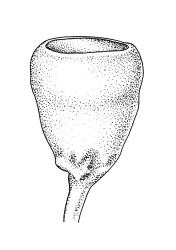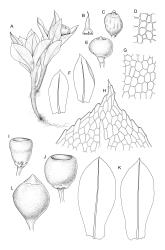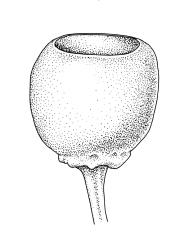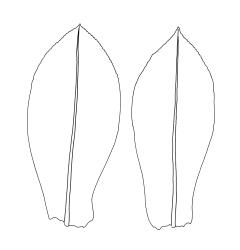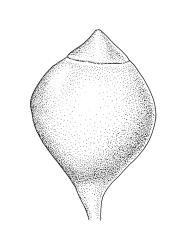- ≡ Gymnostomum pyriforme Hedw., Sp. Musc. Frond. 38 (1801)
- = Physcomitrium conicum Mitt. in Wilson, Bot. Antarct. Voy. III. (Fl. Tasman.) Part II, 197 (1859)
- = Entosthodon physcomitrioides Müll.Hal., Gen. Musc. Frond. 109 (1900) nom. illeg.
Plants medium-sized, gregarious, bright green. Stems branched once by subperigonial innovation, c. 4–11 mm, yellow- or red-brown, in cross-section with a well-defined central strand, beset below with smooth, red-brown rhizoids which lack tubers. Leaves oblong-obovate, acute, c. 2.0–3.0(–3.8) mm, erect-spreading when damp, inrolled and somewhat contorted when dry, plane, weakly concave, bluntly serrate above by projecting cell ends or occasionally nearly entire; upper laminal cells oblong-hexagonal, c. 45–69 × 26–30 μm, becoming longer and more regularly oblong below, c. 4–6 cells inflated but poorly differentiated at alar angles; marginal cells narrower and somewhat longer but not forming a distinct border. Costa green or yellow-brown, c. 60–75 μm wide near base, subpercurrent. Axillary hairs present, with 1 or 2 stalk cells and an oblong terminal cell.
Autoicous. Perigonia terminal and overtopped by a perichaetial innovation. Setae single, red-brown, c. 3–6 mm; capsules globose-pyriform, usually constricted below mouth when dry, 1–1.5(–1.8) × 0.9–1.2 mm, yellow- to red-brown, with a neck to one-third the capsule length; mouth equal the capsule in diameter, flaring when dry; exothecial cells oblong-hexagonal or irregular, firm-walled, not thickened at corners, several rows isodiametric or oblate at mouth; stomata immersed; annulus a single row of round, thinner-walled cells that are smaller than adjacent suboral cells, persistent. Operculum conic or shortly and obtusely rostrate from a plano-convex base. Calyptra often becoming split on one side, covering c. ⅓ of the capsule, falling early. Spores uniformly spinose, 27–39 μm.
Crum & Anderson 1981, fig. 212; Fife 1985, pl. 11c; Malcolm & Malcolm 2003, p. 49.
Physcomitrium pyriforme is easily confused with Tortula truncata, a species with which it often grows on disturbed soils. The present species can be distinguished from the Tortula by several features, including larger leaf cells (those of P. pyriforme are clearly visible under a hand-lens, those of T. truncata are not); shorter costae (subpercurrent vs excurrent in T. truncata); shorter, less pointed opercula; and larger capsules (1.0–1.8 × 0.9–1.2 mm vs <1 mm long, and c. 0.6 mm diameter).
NI: N Auckland, including offshore islands (LB), S Auckland (numerous localities), Hawke’s Bay, Taranaki (Kaitīeke), Wellington (numerous localities). SI: Nelson (Cape Foulwind, Cobden), Marlborough (single collection with no locality given), Canterbury (numerous localities), Otago (numerous localities), Southland (near Riverton).
Probably adventive. Tasmania*, Australia*, North America*, Europe*.
On bare, damp soil, especially silt or clay; often in disturbed habitats such as ditch, stream, or pond margins and on spoil; roadsides and in paddocks, sometimes forming extensive turves. Avoiding deeply shaded situations and tolerant of herbicides. Ranging from near sea level to at least c. 375 m (Waiotapu, S Auckland L.D.) on the North I. and from sea level to at least 500 (Lake Pūkaki, Canterbury L.D.) m on the South I. Capsules normally mature in late spring or early summer. No material has been seen from Gisborne L.D., but this is probably a collection artefact. The species is also undocumented from Westland L.D. Bryobeckettia bartlettii, Bryum dichotomum and other weedy Bryum species, Calliergonella cuspidata, Ceratodon purpureus, and Tortula truncata are frequently closely associated.
Capsules are often more turbinate and the setae are generally shorter in N.Z. material than in European. However, given the considerable variability of the species in other parts of its range, particularly in North America, the variability in N.Z. material provides insufficient reason to recognise the Tasmanian P. conicum. Polyploidy is well documented in P. pyriforme in other parts of its range, but ploidy levels have not been investigated here.
Inter-generic hybrids occur between Bryobeckettia bartlettii and P. pyriforme, and are present in collections of both these species made by W. Martin at Kelso (Otago L.D.). The resultant hybrid capsules seem mainly to be the result of B. bartlettii ♀ × P. pyriforme ♂ crosses and are discussed in greater detail above, under Bryobeckettia.
Wilson (1854) provided the first record of P. pyriforme in N.Z., based on both Colenso and Hooker collections from the Bay of Islands (N Auckland L.D.). Despite these very early records, the weedy habitats invariably occupied by this species make it a strong candidate for adventive status.



